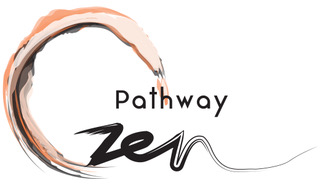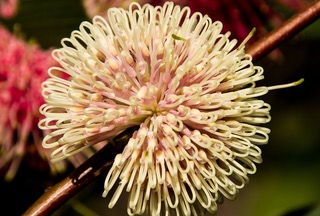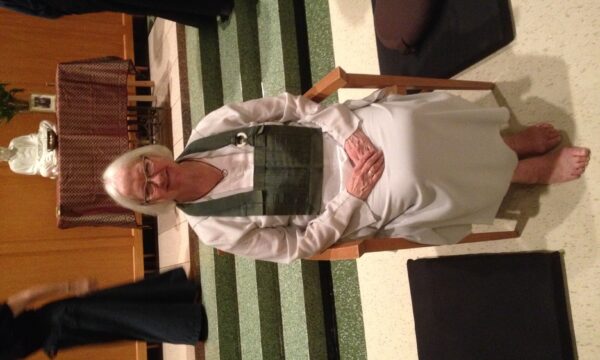Sesshin, (literally “touching the heart-mind”) is an intensive Zen retreat that is structured to guide us in the pursuit of finding our true-self, which is another expression for liberation or breaking through the barrier of dualism.
To this end, a sesshin consolidates all Zen-practices for this purpose and provides the support structure that is required for an extended practice period.
Sesshin is made up of various practice forms that allow us to experience, through mindfulness, the interconnection of all activities.
This is achieved through a disciplined schedule that engages us seamlessly throughout the entire sesshin period.
During a sesshin, our personal commitment to silence binds all practices and activities together. Silence cultivates and heightens our awareness and mindfulness, which lessens our internal and external need to differentiate.
The practice of silence reduces our impulse to add layers of commentary to our activities thus aiding our practice of concentration.
Through the focused concentration of what is at hand (sitting, standing, walking, eating, cleaning..), we build up joriki (concentration power or momentum), which in turn strengthens our capacity to hold and direct our concentration in order to unbind us from our constant mind chatter and conceptual overlaying. Once freed from this cycle, even for a short period, new perspectives open.
Every lapse into mindless speech, social media or intellectual gratification (i.e. reading books) can take us away from our sesshin practice and thus contributes to a weakening of joriki. Joriki is cumulative and builds over a sesshin period.
Silence can be seen as the vein through which all sesshin practices flow and function. The disruption of silence is to be avoided at all cost as once the flow of silence is established, it takes great effort to re-establish it.
A sesshin has a unique character which unfolds as we surrender to our sesshin activities. In a sesshin, we shift our focus from ourselves to simply experience what is at hand.
We allow ourselves to drop our ego-self and to re-emerge with a reference of no self-reference.
How to work with the sesshin rituals:
Samu practice (Housekeeping)
Kitchen work practice, toilet cleaning practice, arranging your bedding practice, vacuum practice, outside window cleaning practice is a seamless practice of movement without differentiations.
The practice of Samu is similar to other activities or ritual practices and grounds us to our ordinary day-to-day activities. Samu, if practiced in this way can be seen as being no different from zazen (sitting meditation).
Samu practice can give us a glimpse of what every koan and dokusan presentation is all about.
Samu is a mindfulness practice that can challenge our perspectives and conceptualisations of our daily work routine.
Chanting and recitation practice
This practice incorporates the daily repetition of Zen chants, mainly derived from Buddhist sutras. They represent condensed teachings that have been handed down to us from our lineage throughout the ages. They are a reminder of how to practice correctly and warn us against delusive interpretations. They can be seen as benchmarks to guide us along the way and compare our state of mind with those that have gone before us on the same path. When our experience mirrors that which is written in these texts, we can be assured that we are on the right track. We can thus get a sense of where we are at in our practice and how far we still have to go. If we can’t understand what is said in the texts, we have perhaps not realized what these sutras point to. They spur us on, encourage us to keep going. They are motivators. Practicing the chants together holds value in that we share this journey with our fellow practitioners. They elevate us to a wholesome mind-state.
Ultimately, like every Zen ritual, the recitations are just recitations, complete in themselves, with nothing to add.
Dokusan practice (going to the teacher alone) –
Dokusan is a ‘not-self’ practice. We go to the teacher alone. No other, no self, empty. We leave our self-conception behind. Dokusan unfolds as it unfolds…
At sesshin, the concentration power or joriki, of both the student and the teacher, is heightened. Because of this, dokusan can seem more intense than when experienced during the weekly dokusan periods.
Dokusan practice, especially for those working on koans, takes on a momentum that is directly linked to the joriki gained during a sesshin.
Koans can seem more alive as we get more clarity and insights through our elevated focus during the sesshin practices.
It is difficult to get to this level of clarity without the practice intensity of a sesshin.
Teisho practice (Koan presentation by a Zen teacher during a sesshin)
The value of a teisho is not so much what is said but what happens during the process. This is because a teisho, unlike a dharma talk, is a presentation about a koan, which points to the absolute.
When we hear a teisho, it can give us a certain assurance and feeling that the process as practiced in Zen is right. We usually forget the words that have been said but we remember a felt-experience when we hear it. It touches something in a way that nothing else does. It resonates to the core of who we are.
Of course we do not feel this with every teisho, but that is the purpose of a teisho compared to a regulardharma talk, which is usually about a teaching or practical aspect of the Dharma. Sometimes it may only be one sentence or one demonstration in a teisho presentation that touches us deeply. When this happens, it is invaluable as it may crack or dislodge some of our habitual ways of perception.
A teisho is therefore not necessarily about content, but about the process of recognising our true-self, through a delivery of a koan presentation.
A teisho is an important part of sesshin practice as it can touch us at our core and has a way to work on us, perhaps unconsciously, through this process.
Participants in a sesshin, exhibit, through their heightened awareness, an ability to intimately connect with what is presented.
Sangha and precept practice
This is perhaps one of the most important aspects of a sesshin. Sangha is not just a word-substitution for our fellow sitters or members. Sangha extends to “all-beings”, which is of course another word for our true-self.
The relationship we have with the world we live in is no other than the relationship we have with ourselves. Being in Sesshin is a practice that allows us to experience this relationship directly and intimately. It opens our eyes and hearts to who and what we are.
The limitations of our practice show-up the most in our relationships. A sesshin provides us with a mirror, reflecting our separation we have with the world. This can be a painful experience as we let go of attachments and our self-righteousness.
At the same time, a sesshin provides an opportunity and space to connect with our source, which is found in the space of non-differentiation.
In a sesshin, our conduct, especially our “mental” conduct is exposed through our heightened awareness and mindfulness practice.
If our thoughts, speech and actions do not align with our values (precepts), it shows up. This can be a very unpleasant experience as we are confronted with our shortcomings in the form of annoyances, judgments, and internal ego confrontations. It is all the more painful, when we realise that we cannot simply turn off this mental anguish.
Sangha or relationship practice keeps us honest as it ultimately validates or invalidates our entire Zen practice. Our shortcomings are reflected over and over again through our relationships or sangha.
Sangha practice is precept practice. The precepts are the tools and guidelines by which we guide our conduct. Precept practice forms an integral part of sesshin practice.
Zazen practice
Zazen can be seen as a means to an end. That is, a concentration and wisdom practice that may eventually lead to a breakthrough and a shift in our perspective to experience the collapsing of our dualistic way of experiencing ourselves and the world.
Once this breakthrough or kensho is achieved, zazen is no longer experienced as a means to an end. Instead, we no longer distinguished zazen as a separate practice or activity from our all other activities. Zazen is experienced as both beginningless and endless.
Zazen draws all practices together.
This occurs in a real way once we experience that we are no longer bound by our conceptual and dualistic limitation of what we think zazen is. That realisation lets us understand Dogen’s saying: “that zazen and enlightenment are one and the same”.
This does not mean however that we drop the practice of zazen once we reached a certain level of awareness. The goal is the path at every step and the path is endless.
Zazen practice can be seen as the driver of all practices, without which, we are easily diverted into delusive thinking.
A consistent and earnest daily zazen practice is a sign of a mature practice.
(Reflections on the purpose of Sesshin, Arno Hess, 2018)




